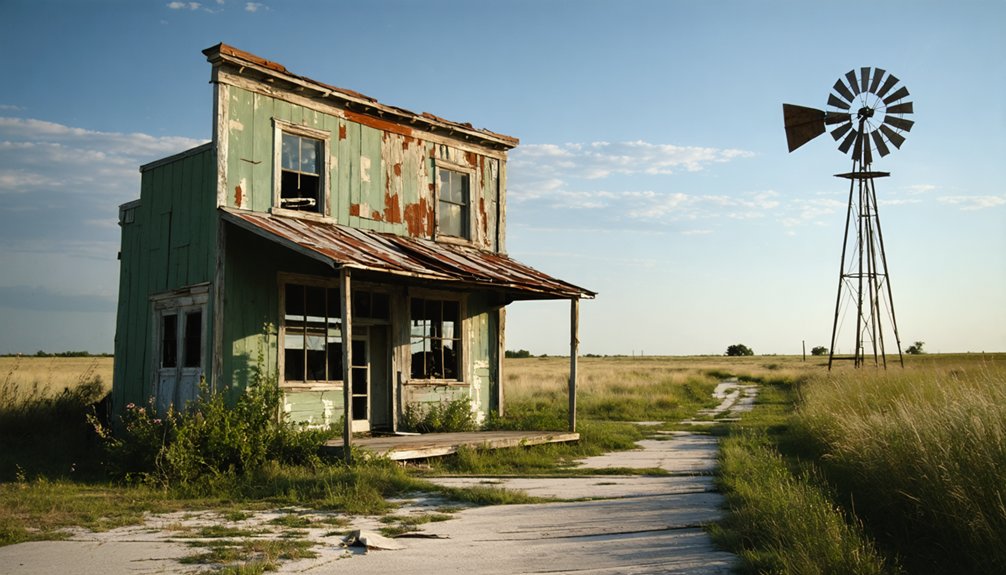You’ll find Emerald’s ghost town remains seven miles east of Ozona in Crockett County, Texas, where it all began in 1889 as a railroad settlement. While not much is left of the original town today, the historic Emerald House still stands as a museum piece in Ozona’s Fairgrounds Park, having been moved twice since its pioneer construction. The story of this Fort Worth and Denver City Railway town holds secrets of family survival, railroad dreams, and Texas determination.
Key Takeaways
- Emerald was founded in 1889 along the Fort Worth and Denver City Railway as Crockett County’s first settlement.
- The town’s survival depended on a single well with windmill, located 85 miles southeast of San Angelo in semi-arid terrain.
- The Emerald House, built in 1889, was relocated to Ozona in 1891 and now stands as a museum in Fairgrounds Park.
- By 1897, essential buildings including the schoolhouse were dismantled, with most structures vanishing into Texas soil over time.
- The town’s legacy continues through preservation efforts of the Historical Commission, despite funding and community engagement challenges.
The Birth of a Railway Town (1889)
Three pivotal events marked the birth of Emerald, Texas in 1889: its founding as a railroad colonization project, its distinction as Crockett County’s first settlement, and its strategic positioning along the Fort Worth and Denver City Railway route.
If you’d been a settler back then, you’d have witnessed firsthand how railroad dynamics shaped this frontier town’s destiny. Like early Amarillo, vast cattle herds were driven to the rail lines for transport to distant markets. As families rolled in, hoping to stake their claim in West Texas’s expanding frontier, Emerald emerged as a promising hub for commerce and community life.
The settlement patterns followed the typical railroad town blueprint – you’d have seen depot buildings sprouting up, worker housing taking shape, and community facilities rising from the Edwards Plateau terrain. The town’s trajectory changed dramatically when the railroad bypassed Emerald, sealing its eventual fate. Folks were betting their future on the iron horse, and Emerald seemed poised to become a thriving railroad center.
Life in Early Emerald
Life in early Emerald centered around the steady rhythm of railway schedules and the close bonds of frontier families making do with what they had.
You’d find most folks living in simple wooden homes or dugouts, their daily routines revolving around the comings and goings of trains. Railway workers kept the tracks humming while their families tended to modest gardens and livestock. Much like in Jericho, residents often gathered at the local Blue Bonnet Club meetings. Similar to the residents of Plemons, they relied on safe river crossings to transport goods and supplies.
Community gatherings brought everyone together at the boarding houses and general stores, where you’d hear tales of frontier life mixed with the latest railway news.
Stories flowed as freely as coffee at local gathering spots, where railway tales mingled with frontier memories and daily gossip.
Your social calendar might’ve included informal get-togethers at neighbors’ homes, though formal institutions were scarce. Water was precious, supplies were basic, and you’d learn to time your activities with the railway’s pulse – it was your lifeline to the outside world.
The Emerald House Legacy
When you step inside the Emerald House, you’ll notice its sturdy pioneer construction that’s helped it endure through decades of West Texas weather and multiple relocations.
The building’s resilience is reminiscent of the hardness of 7.5-8 found in natural emerald gemstones.
As a historic 19th-century home, the Emerald House stands as one of the few remaining structures from the original settlement of Emerald.
You can trace the house’s remarkable journey from its original site in Emerald to its current home at the Crockett County Fair Grounds, where mule teams once hauled it mile by mile to preserve this piece of frontier history.
Your children and grandchildren might still be able to learn from this reminder of early Texas life, but only if today’s preservation efforts can protect it for future generations to appreciate.
Architectural Pioneer Features
Built in 1889 during Texas’s pioneering days, the Emerald House stands as a symbol of frontier ingenuity and family resilience.
You’ll find remarkable pioneer architecture in this historical treasure, which has weathered over 136 years of West Texas living. The house’s sturdy construction allowed it to be moved intact seven miles from Emerald to Ozona in 1891, showcasing the practical mindset of frontier builders. The structure was part of the Fort Worth Railway’s ambitious town-building initiative. Like many one-room schoolhouses, the building served multiple purposes for the community.
Here’s what makes this piece of historical significance special:
- Built with transportable design features that let pioneer families pick up and move when needed
- Constructed using robust framing techniques that have kept it standing strong since 1889
- Adapted to serve multiple generations of Texas families from the 1890s through the 1970s
The Emerald House represents the free spirit and determination of Texas’s frontier families.
Moving Through Time
The remarkable journey of the Emerald House parallels the changing fortunes of West Texas itself.
You’ll find this resilient structure‘s got more lives than a cat – built in Emerald during 1889, then hauled seven miles west to Ozona in 1891 when the county seat shifted.
For near a century, it sheltered countless families, standing tall as a beacon of community stability even after its original town turned to dust.
When 1983 rolled around, folks moved it again to Fairgrounds Park, aiming to make it a museum piece.
Like many of the 511 ghost towns scattered across Texas, Emerald’s story is one of adaptation and survival.
While that dream didn’t pan out, the house’s historical adaptability shines through.
Today, you’re witnessing local champions fighting to preserve this oldest surviving piece of Crockett County heritage for your children’s children to cherish.
Preservation For Tomorrow
Standing proud but precarious, this treasured piece of Crockett County heritage now faces its biggest challenge yet – survival.
You’ll find the Emerald House at Ozona’s Fairgrounds Park, where it’s weathered time but needs your help to keep standing. Without sustainable funding and proper protection, this crucial link to your region’s pioneering spirit could vanish like the ghost town it came from. Like the fate of Route 66 attractions in McLean, neglect has already claimed too many historic structures.
Here’s what’s at stake for your family’s heritage:
- The oldest building in Crockett County needs fencing and signage to ward off vandals.
- Local history programs can’t happen without community engagement and proper facilities.
- Your children’s children deserve to see and touch this piece of railway-era Texas.
The Historical Commission‘s working hard to secure the house’s future, but they’ll need your support to make it happen.
Relocation of the County Seat

During the late 1880s, Potter County’s original county seat faced recurring flooding problems that forced local families to make tough decisions about their future.
You’d have found your neighbors pulling up stakes from J.T. Berry’s waterlogged townsite, following Henry B. Sanborn’s vision of a better life on higher ground to the east.
Your civic engagement would’ve been tested in 1893 when it came time to vote on moving the county seat.
Faced with a historic choice in 1893, Potter County citizens stepped up to decide their community’s future through democratic action.
Sanborn and his partner Glidden sweetened the deal by offering free lots to businesses willing to relocate. They understood that families needed stable ground to build their dreams on.
The old courthouse stood lonely as folks picked up and moved, marking the end of one chapter and the beginning of another in Potter County’s story.
Railroad’s Shifting Priorities
While railroads had initially promised prosperity to small towns like Emerald, you’d have seen a dramatic shift in their priorities by the late 1880s.
As railroad consolidation took hold, companies started favoring more profitable routes through bigger cities, especially with Amarillo dominance on the rise. Your family’s hometown might’ve felt the impact when the rail companies began abandoning those secondary lines that once served as lifelines to smaller communities.
Here’s what sealed the fate of towns like Emerald:
- The P&SF abandoned its Panhandle City to Washburn line in 1908
- Rail companies focused their resources on major commercial routes through Amarillo
- Strategic railway mergers and acquisitions led to the elimination of less profitable small-town connections
Architectural Remnants

Much like the vanishing railroad connections, Emerald’s physical structures tell a poignant story of loss and relocation.
You’ll find precious little ghost town architecture at the original site today – most buildings have disappeared without a trace. The town’s architectural significance now rests mainly with the Emerald House, which folks moved to Ozona back in 1891. It’s your only chance to see how your pioneer ancestors built their homes in late 1800s Texas.
The two-room schoolhouse, once a gathering place for local families, was dismantled and carted off to Ozona by 1897.
The store, well, and railway structures that kept daily life running have all vanished into the Texas soil. Even the familiar sight of a small-town cemetery – something you’d expect to find – isn’t there anymore.
Preservation Challenges Today
As Texas ghost towns face mounting challenges, Emerald’s preservation troubles mirror those seen across the state’s rural landscape.
Y’all can see how funding shortages have hit hard, making it mighty difficult to maintain what’s left of our heritage. Without proper upkeep, these historic treasures are slowly fading away like morning mist.
Here’s what’s making preservation tough in Emerald:
- Limited community involvement due to fewer local families sticking around
- Infrastructure’s falling apart faster than a mud house in a rainstorm, with no money to fix it
- Property values have dropped so low that nobody’s willing to invest in saving these old buildings
It’s a real shame, but without fresh ideas and resources, we’re watching a piece of Texas history slip through our fingers.
The Last Residents

When Emerald’s last residents packed up their belongings in 1897, they left behind more than just empty buildings – they closed the final chapter of a short-lived Texas dream.
These last inhabitants, mostly railway families and shopkeepers, had watched their community dwindle after Ozona nabbed the county seat in 1890. You’d have seen the community dynamics shift as neighbors dismantled their homes piece by piece, hauling the lumber to Ozona where opportunity beckoned.
The schoolhouse, store, and even the historic Emerald House made the journey down the road. Folks simply couldn’t justify staying once the railroad favored Ozona, and that old well wasn’t enough to sustain their dreams.
One by one, Emerald’s buildings found new life in Ozona, leaving behind only memories and an abandoned well.
Today, the Emerald House stands in Ozona as the sole relic to those pioneering families who briefly called Emerald home.
Geographic Significance
The geographic heart of Emerald sat pretty in Crockett County, about seven miles east of what’d become its rival town, Ozona.
You’ll find this ghost town perched at 2,425 feet above sea level, where the semi-arid West Texas winds still whisper tales of frontier dreams.
Geographic isolation and environmental limitations shaped Emerald’s destiny in three key ways:
- The town’s survival hinged on a single precious well with its windmill and storage tank.
- You’d have found yourself 85 miles southeast of San Angelo, making supply runs quite the journey.
- The harsh semi-arid climate limited farming possibilities, leaving ranching as the main livelihood.
The town’s one-square-mile plot, divided into 300 lots, might’ve seemed promising, but without sustained rail connections, Emerald couldn’t overcome its remote location.
Comparing Emerald’s Fate
Looking at how Emerald faded into history, you’ll find its story echoes through other Texas ghost towns where county seat politics changed everything.
Just like Emerald’s decline when Ozona nabbed the county seat in 1890, Plemons met a similar fate when Stinnett took over. Folks up and moved their whole lives, even dismantling Emerald’s schoolhouse brick by brick.
You can see the pattern clear as day – when a town lost its county seat status back in those frontier days, it was pretty much done for.
The railroads played their part too, making or breaking towns with their iron rails. While some ghost towns kept their ruins as evidence to what was, Emerald’s only lasting mark is that old Emerald House, now sitting lonely in Ozona.
Frequently Asked Questions
Are There Any Supernatural Legends or Ghost Stories Associated With Emerald?
You won’t find documented ghostly encounters or haunted locations in Emerald – it’s stayed mighty quiet on that front, with no verified supernatural tales passed down through local families.
What Native American Tribes Originally Inhabited the Emerald Area?
Like threads in a sacred tapestry, you’ll find the cultural heritage of Antelope Creek peoples, who first made their home here, followed by the proud Comanche and Lipan Apache tribes.
How Much Did Land and Houses Cost in Emerald During 1889?
You’d have found land prices and house values weren’t officially recorded back in 1889, but like other Texas frontier towns, you could’ve gotten decent acreage cheap, especially if it wasn’t creek-side property.
What Types of Businesses and Shops Operated in Emerald’s Commercial District?
Ever wonder what life was like back then? You’d find a bustlin’ general store, schoolhouse that doubled as a meetin’ place, and railway company’s water station servin’ the hardworking folk passin’ through.
Did Any Famous Outlaws or Historical Figures Ever Pass Through Emerald?
You won’t find any confirmed outlaw sightings or notable historical figures passing through Emerald. Its brief two-year run and limited historical significance didn’t attract any famous frontier personalities.
References
- https://mix941kmxj.com/the-strange-sad-story-of-a-texas-ghost-town-youll-never-visit/
- https://www.youtube.com/watch?v=FjezViMR1gw
- https://www.preservationtexas.org/mep/emerald-house
- https://jamesbigleyranches.com/general/texas-ghost-towns/
- https://www.hmdb.org/m.asp?m=155119
- https://en.wikipedia.org/wiki/List_of_ghost_towns_in_Texas
- https://www.tshaonline.org/handbook/entries/emerald-tx
- https://www.amarillo-chamber.org/amarillo-history.html
- https://texashillcountry.com/no-yellow-brick-road-to-emerald-texas/
- http://txrrhistory.com/towers/135/135.htm



